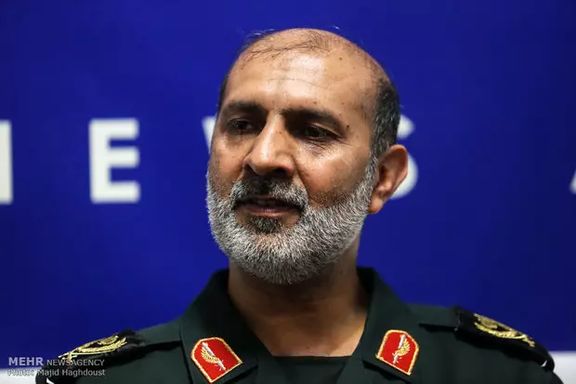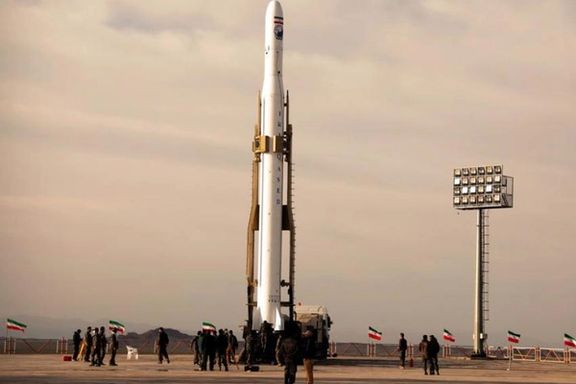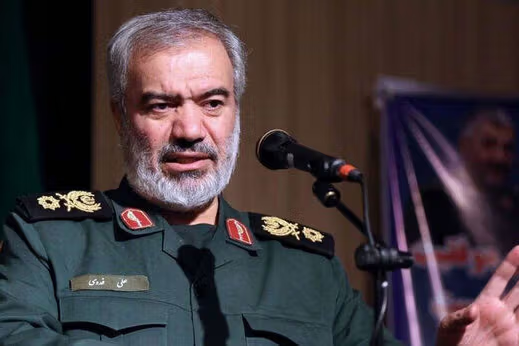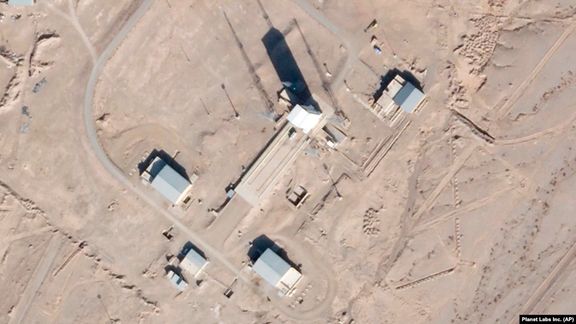Top Military Official Says Iranian Drones Are Not A Threat To Region

A top Iranian military official has dismissed a proposed bill at US Congress to strengthen measures against Tehran’s growing drone program as ineffective.

A top Iranian military official has dismissed a proposed bill at US Congress to strengthen measures against Tehran’s growing drone program as ineffective.
General Rasul Sanairad, the political deputy to the chief commander of Iranian armed forces told Mehr news agency on Wednesday that all previous sanctions on Iran have not worked and the Islamic Republic has been able to make substantial progress in developing weapons systems.
A bi-partisan group of lawmakers in the US House of Representatives presented a bill on December 1 to restrict proliferation of Iran's military drones. The lawmakers behind the proposed legislation, the Stop Iranian Drones Act (SIDA), say it clarifies that US sanctions on Iran’s conventional weapons program under CAATSA (The Countering America’s Adversaries Through Sanctions Act) include the supply, sale or transfer to or from Iran of drones.
Sanairad who represents of Supreme Leader Ali Khamenei insisted that Iran’s weapons are not a threat to neighboring countries. Recent reports have said that Israel and others are concerned over the fast-growing capabilities of Iranian military drones, in addition to its ballistic missiles.
Sanairad went on to accuse Israel of endangering security in the region and threatening safety of navigation. He also questioned the US military’s “illogical” presence in the region.

Iran's hardline President Ebrahim Raisi has allocated 12 times more money to the country's space program in his new budget amid nuclear talks with world powers.
The budget bill for the next Iranian year, which starts on March 21, includes eight trillion rials for the Revolutionary Guard's Aerospace Command, as well as additional budgets to other organizations that contribute to the program.
The 8-trillion rial funding is a modest $35 million if calculated at current business exchange rates, but it is a large sum when most of it is spent in Iran, where salaries and equipment is much cheaper.
This is in contrast to last year's budget in which Rouhani had allocated only 390 billion rials to the Space Organization affiliated with the Ministry of Communication and 280 million rials to the ministry itself to spend on expanding infrastructure. This clearly shows the two government's approaches to boosting the space program.
So far there is no news of the imminent satellite launch foreign media and space monitoring agencies have been talking about during recent days. However, members of the Higher Council for Aerospace Activities have met recently after 11 years, and activities monitored around Iran's launching pads in Semnan area in central Iran indicate that a launch will probably take place.
President Raisi has said that the meeting is indicative of the high priority his government attaches to the space program. Others attending the meeting included General Amir Hajizadeh the commander of the IRGC's Aerospace Force and Foreign Minister Hossein Amirabdollahian.
During the past decade Iran has launched several satellites into space but their journeys in the outer space did not last long. In 2003, one of the Iranian satellites even carried an ape but no one believed the animal Iran showed as the one returning to earth was the same monkey.
Observers outside Iran have charged that Iran's space program is a cover to justify its testing of ballistic missiles. Israel and the United States have said that Iran's space program is against a UN decision saying Iranian missiles should not have nuclear weapons capability.
The activities monitored in the central Iranian desert are similar to preparations made ahead of missile and satellite launches coinciding with nuclear negotiations. There were criticisms in the past that such moves were meant to sabotage any rapprochement between Iran and the West.
After the 2015 nuclear deal, the IRGC launched missiles with Hebrew slogans written on them calling for wiping Israel off the map. The difference this time is that those who are negotiating and those who launch the missiles are not each other's political rivals. They both come from the heart of Iran's hardliner conservative camp.
While monitoring agencies and foreign entities are closely following the moves on the ground, Iran has not been concealing its ambitions in space. Raisi visited a space technology exhibition in Tehran on November 26 and asked officials to work on reaching the 36,000 km orbit around the earth in four years.
The likely blast off at Iran's Imam Khomeini Spaceport comes as Iranian state media has offered a list of upcoming planned satellite launches in the works for the Islamic Republic's civilian space program, which has been beset by a series of failed launches.
While missile and satellite launches in the previous years might had been aimed at disrupting negotiations over Iran's nuclear program, this time it appears that Iranian officials are mainly about to show off Tehran's technological progress and highlight the country's ballistic missile capabilities possibly to scare regional players.

The public, formal part of Iran’s Revolutionary Guard budget will increase 2.4 times next year and Iran’s armed forces will receive crude oil to sell abroad.
In the budget draft bill presented to parliament on Sunday President Ebrahim Raisi’s government proposed a 930 trillion rial budget for Islamic Revolution Guard Corps, IRGC. Last year that number was 380 trillion rials and the year before that was 240 trillion.
The trajectory of ever higher budgets for the IRGC and other entities that directly support and defend the Islamic Republic against domestic opponents is vivid in the new draft. The fiscal year will start on March 21, 2022.
The state broadcaster, the main propaganda arm of the regime and a host of clerical entities will also receive double-digit boosts to the current budgets, while an $8-billion subsidy for imports of food and medicine will be discontinued.
In addition, the government announced that 4.5 billion euros worth of crude oil will be put at the disposal of the armed forces to sell. This means the lion’s share will go to the IRGC, which has to find middlemen and illicit ways to export the oil, giving rise to corruption.
The same scenario happened during former president Mahmoud Ahmadinejad’s presidency in early 2010s, when for example the police was given oil to sell to provide for its needs. In the end it came to light that nearly $200 million of oil revenue in 2012 was never returned to the country.
A businessman, Babak Zanjani, who is now in jail with the death penalty hanging over his head, was a middleman selling oil during international sanctions also in the early 2010s, who failed to pay back at least $2.7 billion. His accomplices in the government were never identified. It would have not been easy for him to embezzle such a large amount of money without insider support.
IRGC has a major role in illicit oil trade. In September 2020, Iran’s oil minister Bijan Zanganeh asked help from IRGC’s business conglomerate, Khatam al-Anbia Headquarters to help circumvent US sanctions and sell crude on international markets.
The increase in IRGC’s formal budget is only the visible part of the all-powerful military’s sources of income. Government organizations all contribute a percentage of their budget to the Revolutionary Guard, in addition to its vast economic and business empire that generates income and pays salaries of many loyalists.
Analysts often try to estimate IRGC’s budget in US dollars, a difficult task given various exchange rates applicable in Iran and determining what part of its expenses and to what extent are in dollars. For example, the current formal budget would be around $3.5 billion calculated in free-market rate, but using a government exchange rate, it comes closer to $5 billion.
Perhaps a better gauge is to look at Iran’s annual inflation rate. This year inflation hovers around 45-50 percent, but IRGC’s proposed budget jumped 2.4 times. Moreover, the government is proposing to increase salaries of its administrative and industrial workers by 10 percent, which is way below the inflation rate.
Tens of thousands of teachers protested nationwide on Monday for higher pay to keep up with a nearly 50-percent annual inflation. The state has delayed the implementation of a law that would have boosted teacher’s pay, arguing that it has no money amid US sanctions.

The deputy commander of Iran’s Revolutionary Guard has said that Iranian universities and academics have been useful in advancing military development projects.
Ali Fadavi told the official government news website IRNA on Tuesday, December 14, that in the IRGC navy “A lot of cooperation and activities have taken place with universities,” that have not been mentioned due to their secret nature.
He added that 14 universities helped boost Iran’s naval capabilities and played an important role in many other areas.
“We in the Islamic Revolution Guard Corps have used the capabilities of students, researchers and academics at different times and for a variety of problems, especially in the most difficult tasks, meaning in the military field,” Fadavi was quoted as saying.
In the Islamic Republic authoritarian system all resources are at the disposal of the state, especially military and security organs, but since the 1979 revolution and especially in the past decade, Iran has suffered from a “brain drain”, as more educated younger people have been leaving the country in significant numbers.

Iran appears to be preparing for a space launch as talks continue in Vienna over its tattered nuclear deal, according to an expert and satellite images.
The likely blast off at Iran's Imam Khomeini Spaceport comes as Iranian state media has offered a list of upcoming planned satellite launches in the works for the Islamic Republic's civilian space program, which has been beset by a series of failed launches.
Iran’s President Ebrahim Raisi visited a space technology exhibition in Tehran on November 26 and asked officials to work on reaching the 36,000 km orbit around the earth in four years.
Currently Iran is attempting to place satellites in the 500-kilometer orbits.
Minister of Communications and Information technology, Issa Zarepour, who supervises Iran’s space program had told local media that the project to reach the high orbit was planned to be accomplished in 10 years, but Raisi asked to speed up the program. The president pledged all the assistance needed to help Iran’s Space Agency.
Iran's Revolutionary Guard runs its own parallel program that successfully put a satellite into orbit last year.
Satellite images taken Saturday by Planet Labs Inc. show activity at the spaceport in the desert plains of Iran's rural Semnan province, some 240 kilometers (150 miles) southeast of Tehran.
A support vehicle stood parked alongside a massive white gantry that typically houses a rocket on the launch pad. That support vehicle has appeared in other satellite photos at the site just ahead of a launch. Also visible is a hydraulic crane with a railed platform, also seen before previous launches and likely used to service the rocket.
Conducting a launch amid the Vienna talks fits the hardline posture struck by Tehran's negotiators, who already described six previous rounds of diplomacy as a "draft," exasperating Western nations. British and German foreign minister have gone as far as to warn that "time is running out for us at this point."
The United States and other countries are concerned that Iran’s satellite program is a cover for developing ballistic missiles that can exceed the current 2,000 km range of Iranian vehicles. Regional and Western countries say that beyond Iran’s nuclear program, its ballistic missiles should also be curbed. Highlighting a space program, Tehran can argue that it needs the technology for peaceful, space related efforts.
But all this fits into a renewed focus on space by Iran's hardline President Ebrahim Raisi, said Jeffrey Lewis, an expert at the James Martin Center for Nonproliferation Studies at the Middlebury Institute of International Studies who studies Tehran's program.
With Iran's former President Hassan Rouhani who shepherded the nuclear deal out of office, concerns about alienating the West with the launches likely have faded.
"They're not walking on eggshells," Lewis told AP. "I think Raisi's people have a new balance in mind."
With reporting by AP

Iran’s Army has announced that a homegrown intelligence gathering ship has been developed and being tested for deployment, Fars news agency reported on Sunday.
The vessel named Shiraz is the first destroyer class warship capable of housing a helicopter and a revamped deck for Iranian-developed radars.
Fars quoted the commander in charge of the Army’s naval industries as saying that Shiraz has a wide array of equipment for electronic warfare and intelligence gathering, developed by national resources. The ship is in the final stages of testing he said, and will join the Army’s navy.
There is no independent confirmation of the claim.
While Iran’s traditional Army (Artesh) has its own navy and manages most of Iran’s naval development projects, the Revolutionary Guard also has its own navy. Iran has been forced to rely on its homegrown means to maintain a navy as a previous UN arms embargo and sanctions have prohibited the open acquisition of arms.
Satellite imagery and footages that emerged a week ago showed an Iranian naval vessel which was under construction at Bandar Abbas port had capsized. The identity and type of the vessel remained unknown, and Iran never acknowledged the incident.